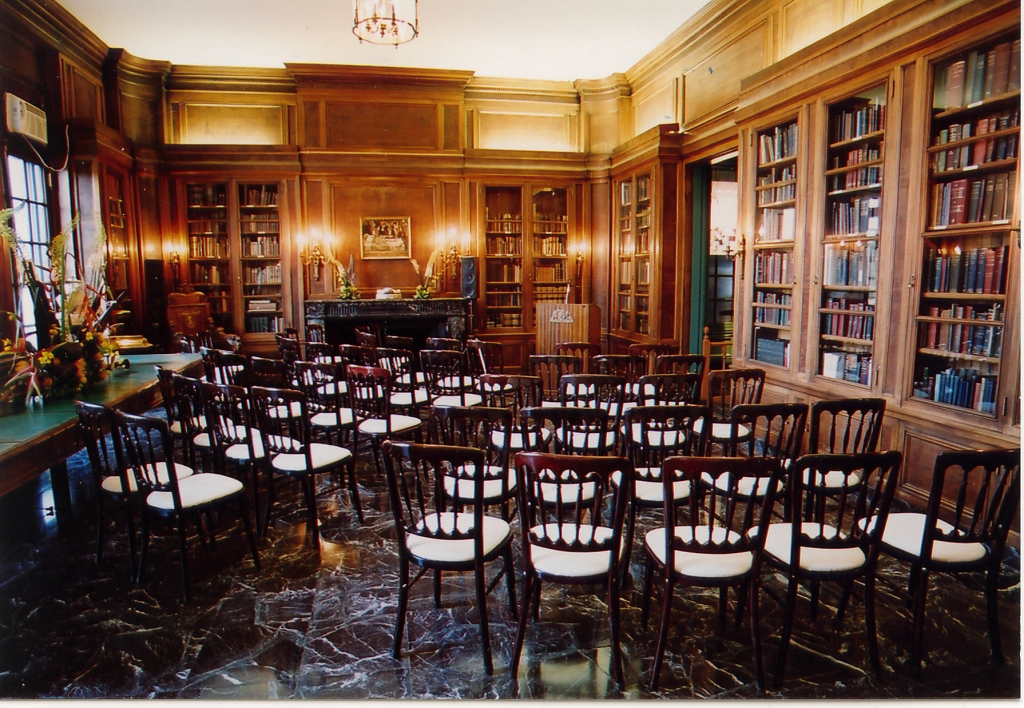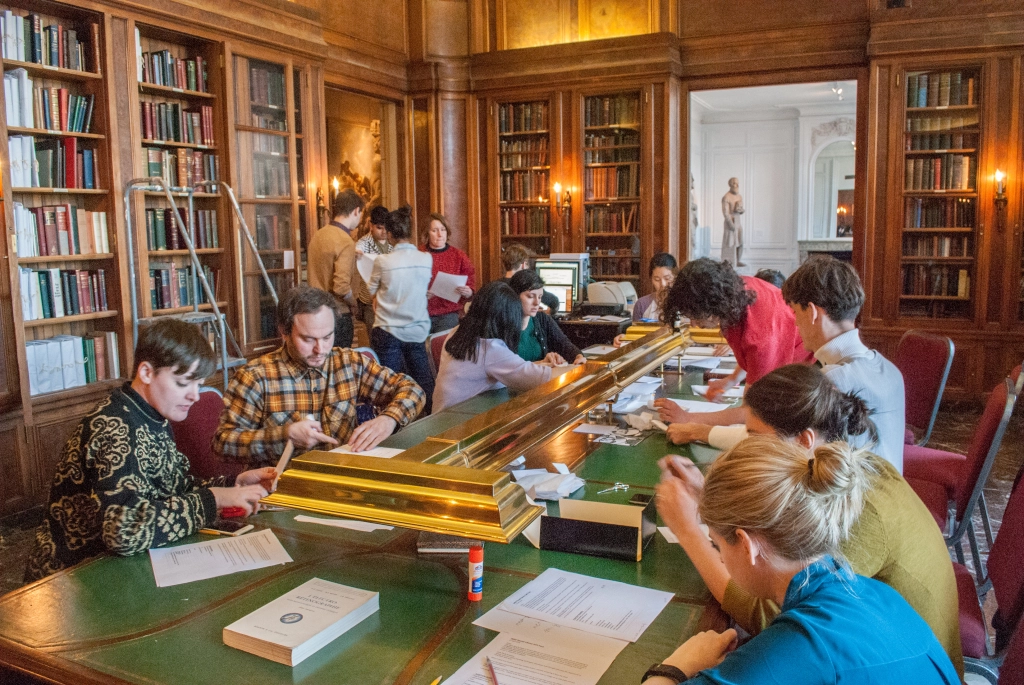

How many times have you driven by the address 1524 Jean-Baptiste Pointe DuSable Lakeshore Drive and either noticed or failed to notice the International Museum of Surgical Science with its imposing statue Hope & Help sculpted by Edouard Chassaing? You may have thought it would be an interesting place to visit. It is not just interesting; it is downright fascinating. The International Museum of Surgical Science (IMSS) is a historic, monumental, palatial Gold Coast Mansion. The IMSS itself is an intriguing adaptive reuse landmark with so much unsung history, romance, marble, and gilded staircases.

On July 9th we attended the opening reception for the award-winning artist James R. Wilke who researched the effects of the smallpox epidemic called Pox Americana. Wilke has written a play, still in development, based on Toni Morrison’s novel A Mercy. We were treated to a reading by seven talented actors of his adaption. There are also two exhibits created by Wilke that cover smallpox worldwide throughout history. During the American Revolution Inoculations were very different and promoted by Commander George Washington. It was a process called variolation in which smallpox sores (pustules) were scratched into arms or inhaled through the nose. I was surprised to learn there were anti-vaxxers even back then.

According to its website, one of the stated missions of “the IMSS continues its active role in supporting Chicago and Illinois arts and artists through its Artist in Residency and “Anatomy in the Gallery” rotating contemporary art galleries. James R. Wilke’s capstone exhibition, “Pox Americana: How Smallpox Once Plagued America & The World,” opens on July 9th, 2022, and is on view through August 28, 2022. The Museum will host an opening reception on July 9 from 6-8:30 p.m. that is free and open to the public.” This is a very significant event in history with timely implications for our own times of the Covid pandemic and the rise of Monkeypox. Besides this exhibition, you will enjoy the architecture and other educational and artistic displays of this museum.

Originally built in 1917 as a private residence for Chicago socialite Eleanor Robinson Countiss, an heir to the fortunes of the Diamond Match Company. She was an entrepreneur and remembered for her socially progressive activities in Chicago and service to the Red Cross. Her home-hosted luminary glitterati of the time including the Drakes, Mortons, and Shedds. She even hosted the Pulitzer-winning author, Edna Ferber, who was recovering from a rhinoplasty procedure. It is rumored that the novel So Big was inspired by Eleanor Countiss when she divorced her first husband in 1923 to marry the man she fell in love with Lawrence H. Whiting. She married him in 1925. Together they founded the American Furniture Mart now known as the Merchandise Mart. She modeled her home after the Neoclassical Petit Trianon in Versaille, Marie Antoinette’s residence.

Howard Van Doren Shaw, whose father served on the planning committee for the Chicago World’s Columbian Exposition was the architect. Howard Van Doren was a celebrated architect to wealthy Chicagoans of the time and was responsible for the construction and attention to detail of this impressive mansion that has stood the test of time.

The 30-room mansion covers 18,000 square feet of living space and remained in the family until 1950 when Dr. Max Thorek purchased it and opened it to the public as the International Museum for Surgical Science in 1954. He founded the IMSS in 1935 for the purpose of sharing surgical knowledge worldwide. The IMSS has a Taiwan and Japanese Room and gives credence to Eastern and Western Medicine. Dr. Thorek, himself was a brilliant surgeon, musician, research scientist, prolific author, and photographer with works at the Art Institute of Chicago. He was a Renaissance man with extraordinary talents and his own fascinating history.

Dr. Thorek was born in March 1880 in Hungary to parents both in the medical field. His father was a doctor and his mother a midwife with an obstetrics degree. He was studying in Budapest when his brother was killed in a pogrom. His family fled after this tragedy and settled on the West side of Chicago where they had relatives. There was no money for Max to continue his studies until he got creative. He was a violinist with an itinerant orchestra and heard that the University of Chicago offered scholarships to its band members. Unfortunately, they had no need for a gifted violinist, but they were desperate for a snare drum player. He bluffed his way through an interview and then purchased a snare drum at a pawn shop. His fellow roving musicians taught him to play the snare drum so he could snag an education at U of C graduating in 1904.

From there he graduated medical school at Rush and teamed up with Surgeon Greenspan. Together they established the American Hospital in 1911, now known as Thorek Memorial Hospital on Irving Park Road, They served and cared for the performing arts community. Among his patients were poor entertainers along with celebrity stars such as Houdini, Mae West, the Marx Brothers, and Buffalo Bill Cody. “The International College of Surgeons (ICS) has a long and inclusive history, dating to 1935, with 85 years of being open to all nationalities, all races, and all creeds.” <www.icsglobal.org>

The IMSS is an excellent excursion for those interested in art, architecture, Chicago history, medical science, and technology. It has skeletons, skulls, an iron lung, prosthetics, plus historical medical tools, that look more like tools of torture than implements of healing. All exhibits are artfully curated to educationally inform and entertain your macabre curiosity. On their Plan Your Visit Website they have Covid-19 regulations, museum directions, and discounted parking sites available with validation. The staff is very friendly, welcoming, and knowledgeable.
Hours of Operation Monday 9:30 am to 5:00 pm
Tuesday 9:30 am to 5:00 pm
Wednesday 9:30 am to 5:00 pm
Thursday 9:30 am to 5:00 pm
Friday 9:30 am to 5:00 pm
Saturday 10:00 am to 5:00 pm
Sunday 10:00 am to 5:00 pm
Adults–$17.00 Seniors (age 65+), Educators, Students and Members of the Military (with ID) $13.00, Children 4-13- $9.00 Members and Children 3 and under are free.
Photos: Courtesy of International Museum of Surgical Science unless otherwise indicated.

Be the first to comment